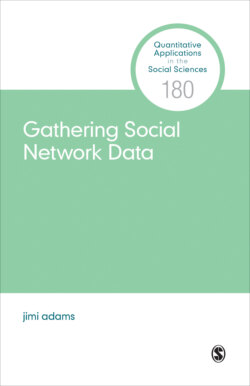Читать книгу Gathering Social Network Data - jimi adams - Страница 13
На сайте Литреса книга снята с продажи.
Description, Network Theories, and Theories of Networks
ОглавлениеHistorically, social network research has often pursued one of three primary empirical aims—(1) description, (2) explanation that focuses on “theory of networks,” or (3) “network theories” (Borgatti & Lopez-Kidwell, 2011). Social network description, in and of itself, has a fundamentally different flavor than descriptive statistics provide for individually oriented data. Perhaps most popularly, Emirbayer (1997) sets relational sociology up against what he labels as research that is more substantialist (or essentialist) in nature. Substantialist research assumes that the characteristics and processes that socially matter belong to (are the substance of) the units being analyzed (e.g., individuals).
Contrastingly, a relational sociology takes as its focus the patterns of the relationships between those units. This relational social science requires an entirely different set of analytic techniques—social network analysis (SNA). SNA often provides the first way scholars are introduced to social network research.5 Networks consist of nodes and ties. As the focus of network research, the ties can consist of a number of different types of ties, theoretical orientations deriving from those ties, and ways for conceptualizing what it is about these ties that we want to capture as researchers. As such, these relational possibilities will be the focus of the theoretical ideas in the remainder of this chapter and the methods presented in the next couple of chapters. But what about the nodes? It’s vitally important to recognize that network nodes can represent any number of entities. There is excellent research focused on the relationships between individuals, organizations, and even countries.6 Here, I assume that SNA is equally applicable across these different types of nodes but describe methods that generally only address one of these at a time within any given study—as this is the most common practice.
5 For a few excellent introductory resources summarizing these analytic approaches, see Appendix A.
6 Wellman (1988) contends that analytically, those different types of nodes can be treated more or less interchangeably, while recent theoretical advances have pointed out ways that different types of nodes and levels of analysis likely lead to different conceptualizations of why and how networks matter (Borgatti & Lopez-Kidwell, 2011).
With relational patterns the focus of SNA, our descriptive tools provide the language necessary to capture the common and influential patterns observed in networks, incorporating a few families of different types of relational patterns, each of which can be observed across a range of network types.7 As a few quick examples drawing on the graph in Figure 1.1, this type of network description provides the tools to account for the ways that Nodes 4 and 5 differ from each other8 or what the defining differences are between the groups of nodes {4,7,8} compared to {3,4,5}.9
7 Broadly, these generally include measures of: ego network size and composition, balance or other features of local network structure, distance, density, centrality, clustering and cohesion, and equivalence (Knoke & Yang, 2007; Wasserman & Faust, 1994).
8 For example, Node 4 is more central on virtually all known measures of centrality than Node 5.
9 For example, the former group is more structurally cohesive, but each group would be identified as socially balanced.
Figure 1.1 Example Simple Directed Network
Beyond descriptive studies—although it should be noted that some critics have suggested this comprises the bulk of the field (for counterarguments, see Borgatti & Lopez-Kidwell, 2011; Borgatti, Mehra, Brass, & Labianca, 2009)—social network scholarship with explanatory goals generally has one of two orientations. Network theories ask how network structure shapes other outcomes of interest (i.e., networks as cause). For example, this perspective can be used to examine topics such as disease flow through a population, success or failure of job searching strategies, and integration of familial and economic resources. Alternatively, theories of networks aim to identify the sources of network structure and change (Borgatti & Lopez-Kidwell, 2011; Fuhse, 2019)—for example, who chooses whom as friends, how one becomes a central arbiter of commodity exchange in a market, and so on (i.e., networks as effect). In either of these types of questions, network structure—whether as the primary explanans or explanandum—is a fundamentally relational feature. That which does the explaining or is to be explained derives primarily from the pattern of the ties among the studied population’s actors. Scholars have recently sought to expand the variety of theoretical arguments available to provide explanations in empirical studies, and I encourage readers to explore this rich literature separately to enhance their reading of this book (see, e.g., Erikson, 2013; Fuhse, 2019; Valente & Pitts, 2017). While these sources can provide a more comprehensive view of the theoretical bases of social networks research, I briefly summarize two of the more prominent streams below. These turn from the types of (descriptive or analytic) questions that animate networks research to the potential mechanisms that feature in the answers to those questions.
